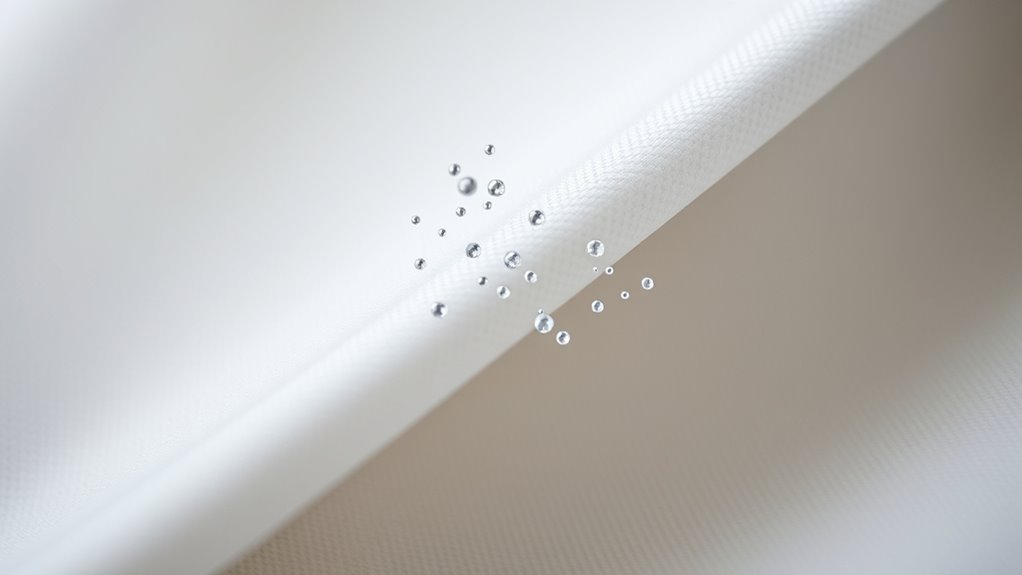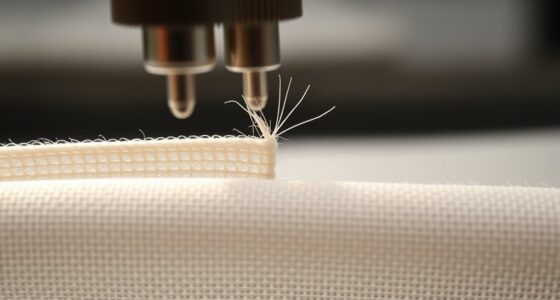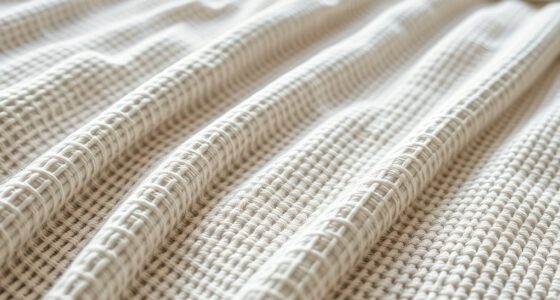Anti-odor fabrics fight smells by using special textile treatments that actively neutralize bacteria and fungi responsible for unpleasant odors. These treatments are integrated during manufacturing and designed to last through multiple washes, so your clothes stay fresher longer. They also incorporate moisture-wicking properties to reduce bacterial growth and improve comfort. By preventing odor formation rather than masking them, these fabrics offer an eco-friendly and durable solution. Keep exploring to discover more about how these smart textiles work.
Key Takeaways
- They incorporate textile treatments that neutralize bacteria and fungi responsible for odor formation.
- The fabrics are designed to prevent bacteria growth rather than mask smells.
- Many treatments use eco-friendly, non-toxic, and biodegradable methods for sustainable odor control.
- Anti-odor fabrics often include moisture-wicking properties that reduce bacterial growth caused by sweat.
- The odor-resistant effects are long-lasting, maintaining effectiveness even after multiple washes.

Have you ever been frustrated by persistent odors in your clothing or sports gear? It’s a common problem, especially when you’re active or live in humid environments. Luckily, anti-odor fabrics are stepping up to solve this issue, and they do so through a combination of advanced technology and responsible manufacturing practices. These fabrics aren’t just about masking smells—they actively prevent them from forming in the first place. This is possible because of innovative textile treatments, which are applied during the manufacturing process to give the fabric long-lasting odor control. These treatments work by neutralizing bacteria and fungi that cause unpleasant odors, so your clothes stay fresher for longer, even after intense workouts or long days. Many of these fabrics also incorporate yarn for scarves that enhances their durability and performance, making them suitable for various activewear and everyday clothing.
What sets anti-odor fabrics apart is their focus on sustainable manufacturing. Instead of relying on chemical-laden sprays or sprays that wash out quickly, manufacturers are now adopting eco-friendly processes that minimize environmental impact. They incorporate sustainable materials and eco-conscious production practices, ensuring that the anti-odor properties don’t come at the expense of the planet. This means that the treatments used are often non-toxic, biodegradable, and free from harmful chemicals, making them safer for both you and the environment. As a result, you can enjoy odor-free clothing without feeling guilty about contributing to pollution or waste.
The innovation behind these fabrics doesn’t stop at environmental concerns. The textile treatments are designed to be durable, so the anti-odor effect remains effective wash after wash. You won’t need to reapply sprays or buy new clothes frequently—these fabrics are built to last. This longevity not only saves you money but also reduces waste, aligning with the principles of sustainable fashion. Plus, many of these fabrics are crafted with moisture-wicking properties, helping to keep sweat away from your skin and further reducing the environment for bacteria to thrive. That means less odor, more comfort, and less washing, which conserves water and energy.
In essence, anti-odor fabrics combine cutting-edge textile treatments with sustainable manufacturing to give you a practical, eco-friendly solution to persistent smells. They’re designed to perform under real-world conditions and stand the test of time, all while caring for our planet. So, whether you’re hitting the gym, running errands, or just want your everyday clothes to stay fresh longer, these fabrics are revolutionizing the way we think about odor control—smart, sustainable, and effective.
Frequently Asked Questions
Are Anti-Odor Fabrics Safe for Sensitive Skin?
Yes, anti-odor fabrics are generally safe for sensitive skin, but it’s important to take into account skin irritation and chemical safety. Some fabrics may contain chemicals or treatments that could cause irritation for sensitive skin types. Look for options labeled as hypoallergenic or free from harmful chemicals. Always check product labels, and if you have known sensitivities, do a patch test before regular use to ensure comfort and safety.
How Long Do Anti-Odor Treatments Last?
Anti-odor treatments last like a gentle breeze, gradually fading over time. Typically, their treatment durability spans around 30 to 50 washes, though this varies depending on fabric care and usage. For scent longevity, expect it to diminish after several washes, but proper washing methods help extend the effects. To keep your anti-odor fabrics fresh longer, follow manufacturer instructions and avoid harsh detergents.
Can Anti-Odor Fabrics Be Washed Repeatedly Without Losing Effectiveness?
Yes, you can wash anti-odor fabrics repeatedly without losing effectiveness, but fabric durability and washing frequency matter. Follow the care instructions to maintain their odor-fighting properties, as harsh detergents or high temperatures can degrade the treatment. Generally, gentle washing and avoiding overuse of strong chemicals help preserve their odor-neutralizing abilities, so you can enjoy their benefits through many laundry cycles.
Do Anti-Odor Fabrics Work Against All Types of Odors?
Anti-odor fabrics generally work well against many odors by targeting fabric odor mechanisms and odor molecule binding. However, they might not be effective against all types, especially strong or persistent smells like smoke or certain chemicals. You should be aware that their effectiveness depends on the specific odor molecule and how well the fabric’s treatment can bind and neutralize it. For best results, follow care instructions and consider the odor type.
Are Anti-Odor Fabrics Environmentally Friendly?
Anti-odor fabrics can be eco-friendly, especially when made with sustainable materials and treated with eco-friendly options. Many brands now use chemical-free treatments, reducing environmental impact. You can choose fabrics that prioritize eco-conscious manufacturing processes, helping you fight odors while also supporting sustainability. By opting for these environmentally friendly options, you get effective odor control without harming the planet, making your choice both practical and responsible.
Conclusion
So, savvy shoppers, selecting anti-odor fabrics means staying fresh longer and fighting foul smells fiercely. With their innovative ingredients and impressive odor-absorbing powers, you can confidently conquer daily odors. By choosing these clever textiles, you make your wardrobe worry-free and wonderfully welcoming. Remember, fabric flexibility and freshness go hand in hand—fighting funk has never been so simple, swift, and sensational. Stay smart, stay fresh, and let anti-odor fabrics keep you confidently comfortable every day.









